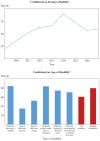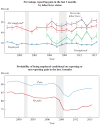Where Have All the Workers Gone? An Inquiry into the Decline of the U.S. Labor Force Participation Rate
- PMID: 30739945
- PMCID: PMC6364990
- DOI: 10.1353/eca.2017.0012
Where Have All the Workers Gone? An Inquiry into the Decline of the U.S. Labor Force Participation Rate
Abstract
The U.S. labor force participation rate has declined since 2007, primarily because of population aging and ongoing trends that preceded the Great Recession. The labor force participation rate has evolved differently, and for different reasons, across demographic groups. A rise in school enrollment has largely offset declining labor force participation for young workers since the 1990s. Labor force participation has been declining for prime age men for decades, and about half of prime age men who are not in the labor force may have a serious health condition that is a barrier to working. Nearly half of prime age men who are not in the labor force take pain medication on any given day; and in nearly two-thirds of these cases, they take prescription pain medication. Labor force participation has fallen more in U.S. counties where relatively more opioid pain medication is prescribed, causing the problem of depressed labor force participation and the opioid crisis to become intertwined. The labor force participation rate has stopped rising for cohorts of women born after 1960. Prime age men who are out of the labor force report that they experience notably low levels of emotional well-being throughout their days, and that they derive relatively little meaning from their daily activities. Employed women and women not in the labor force, by contrast, report similar levels of subjective well-being; but women not in the labor force who cite a reason other than "home responsibilities" as their main reason report notably low levels of emotional well-being. During the past decade, retirements have increased by about the same amount as aggregate labor force participation has.
Conflict of interest statement
Conflict of Interest Disclosure: The author received financial support for this work from the Federal Reserve Bank of Boston and the National Institute on Aging. With the exception of the aforementioned, the author did not receive financial support from any firm or person for this paper or from any firm or person with a financial or political interest in this paper. He is currently not an officer, director, or board member of any organization with an interest in this paper. No outside party had the right to review this paper before publication. declined, and the retirement rate is expected to continue to rise. A meaningful rise in labor force participation will require a reversal in the secular trends affecting various demographic groups, and perhaps immigration reform.
Figures













References
-
- Aaronson Stephanie, Cajner Tomaz, Fallick Bruce, Galbis-Reig Felix, Smith Christopher, Wascher William. Labor Force Participation: Recent Developments and Future Prospects. Brookings Papers on Economic Activity, Fall. 2014:197–255.
-
- Aaronson Stephanie, Fallick Bruce, Figura Andrew, Pingle Jonathan, Wascher William. The Recent Decline in the Labor Force Participation Rate and Its Implications for Potential Labor Supply. Brookings Papers on Economic Activity. 2006 Spring;:69–134.
-
- Abraham Katharine G, Kearney Melissa S. Working Paper no. 24333. Cambridge, Mass: National Bureau of Economic Research; 2018. Explaining the Decline in the U.S. Employment-to-Population Ratio: A Review of the Evidence.
-
- Aguiar Mark, Bils Mark, Charles Kerwin Kofi, Hurst Erik. Working Paper no. 23552. Cambridge, Mass: National Bureau of Economic Research; 2017. Leisure Luxuries and the Labor Supply of Young Men.
-
- Autor David H, Dorn David, Hanson Gordon H. The China Syndrome: Local Labor Market Effects of Import Competition in the United States. American Economic Review. 2013;103(6):2121–68.
Grants and funding
LinkOut - more resources
Full Text Sources
Miscellaneous
